J.C. penny ill equipped for holiday price wars.
jc penny ill equipped for holiday price wars. vulnerable to penny pinching consumers and u.s. government. via bloomberg [RK]
jc penny ill equipped for holiday price wars. vulnerable to penny pinching consumers and u.s. government. via bloomberg [RK]
 seung-yong song, bethan laura wood and jon stam | click > enlarge
seung-yong song, bethan laura wood and jon stam | click > enlarge
Continuing its commitment to innovation in design, W Hotels Worldwide unveiled the works of the 2013 W Hotels Designers of the Future Award winners during Design Miami/ Basel (June 11-16, 2013). Now in its fourth year, the collaboration between W Hotels and Design Miami/ seeks to give emerging designers a global platform from which to showcase their work.
This year for the first time the three winning designers were sent to specific new or renovating W Hotels to solve a particular design challenge or need. In addition to being showcased at Design Miami/ Basel, the newly commissioned, site-specific works will later be installed at W Hotels in Verbier, where the W brand’s first ski retreat will debut later this year; Bangkok, which opened in December 2012; and Mexico City, which will soon undergo renovation.
“Design has been core to the DNA of the W Hotels brand since our inception in New York City nearly 15 years ago,” said Paul James, Global Brand Leader, W Hotels, St. Regis and The Luxury Collection. “The W Hotels Designers of the Future Award allows us to work with the best emerging design talent from around the world, while providing a global platform of exposure for these young talents during Design Miami/ Basel and beyond.”
For this year’s commission, the winners, including Seung-Yong Song (Korea), Jon Stam (Canada) and Bethan Laura Wood (UK), have unveiled their interpretation of the brief, entitled “Making Connections.” Each designer’s project facilitates exchange between local communities and the international visitors who pass through them, whether for business or leisure. The goal of these projects is to deepen the appreciation for the distinct regional characteristics found in each destination.
“The W Hotels Designers of the Future Award has become an important incubator for emerging talents, allowing the winners to develop a project and directly interact with the receptive audience at Design Miami/ Basel,” said Marianne Goebl, Director of Design Miami/. “This year, the award is brought to yet another level by incorporating a research trip. We are thrilled to see the designers’ experiences reflected in their projects in a meaningful and engaging way.”
[ Making Connections ]
Seung-Yong Song’s Wheeljek Collection was created for W Bangkok and takes its inspiration from the fluidity and flexibility of the city’s ubiquitous street food carts. Observing the ingenuity of the design of this everyday object, Song was struck by the many uses of the carts in the bustling capital; it is at once a means of transporting goods, a kitchen, a restaurant and a bar. His collection takes the street cart concept and transforms it into an object which can be adapted to suit the user’s needs and modified into various forms and sizes, from cart to table to storage.
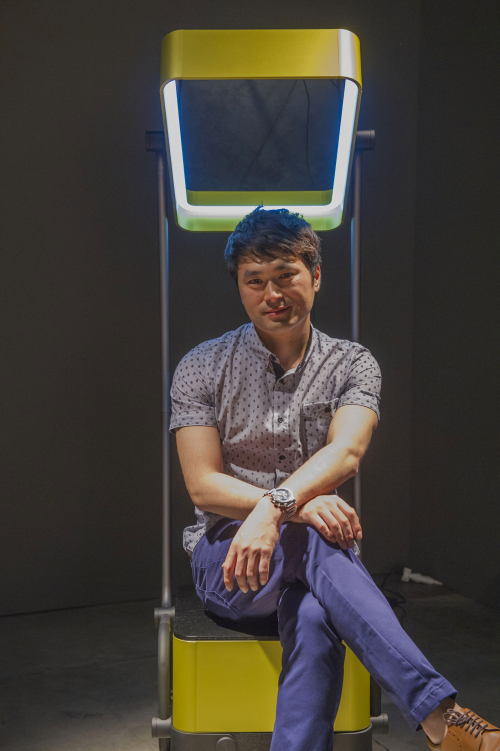
Designed for W Verbier, Jon Stam’s Claude Glass is an abstract timepiece that captures the landscape of the small Swiss village throughout the seasons. Stam has collaborated with local photographer Guido Perrini to capture Verbier within a digitized black mirror where one can speed up or reverse time by turning the object. As most tourists experience the destination during its world renowned ski season, Claude Glass provides a medium for a different kind of travel, showcasing the picturesque locale all year long.
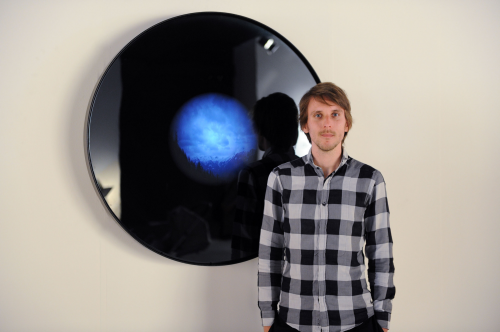
Bethan Laura Wood’s Crisscross is a glass fixture created for W Mexico City and designed to evoke a cascade of floating flowers. The work combines a range of influences taken from the city, from its colorful markets and graphic displays of flowers to the Aztec-meets-Deco architecture and triple-relief Baroque detailing. Wood has enlisted the specialist skills of two different worlds of glass – artisan Pedro Myver, a Pyrex master in Italy, and Nouvel Studio, the Mexican colored glass specialists – to make work that crosses the boundaries of local and global, acting as a conduit for creative communication.
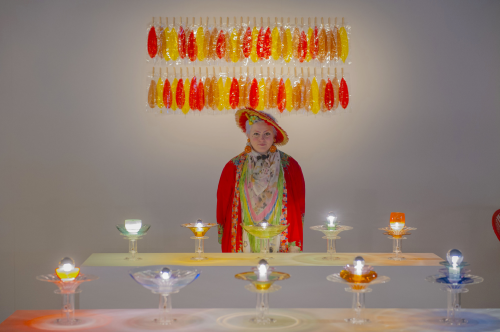
[ designers of the future ]
Started in 2006 at Design Miami/ Basel, the Designers of the Future Award recognizes up-and-coming designers and studios that are expanding the field of design. Each year, three designers or studios are selected as a way to honor a variety of approaches in the constantly evolving landscape of contemporary design. The Award moves beyond pure product and furniture design to acknowledge technologically and conceptually vanguard pieces that work across multiple disciplines, offering the next generation of design creatives the opportunity to present newly commissioned works to an influential audience of collectors, dealers, and journalists at Design Miami/ Basel.
The W Hotels Designers of the Future Award also draws attention to design practices that exemplify new directions for the design field, and as W Hotels continues to grow globally, the Award provides the W design and innovation teams with access to the world’s brightest talent in contemporary design. The objective for W Hotels is to create a vision of how guests may conceptually interact with cutting-edge and technologically advanced design solutions throughout hotel Living Rooms (the W brand’s re-interpretation of the hotel lobby) and guestrooms globally.
The winners were selected by an international jury that included Jan Boelen of the Design Academy Eindhoven and Z33; Tony Chambers of Wallpaper* magazine; Aric Chen of M+ Museum Hong Kong; Alexis Georgacopoulos of Ecole Cantonale d’art de Lausanne (ECAL); Marianne Goebl of Design Miami/; Benjamin Loyauté, author, curator and journalist; and Mike Tiedy of Starwood Hotels & Resorts, parent company of W Hotels Worldwide.
Qualifying candidates for the W Hotels Designers of the Future Award must have created original works in the fields of furniture, lighting, craft, architecture and/or digital/electronic media. Candidates must have been practicing for less than 15 years and have produced a body of work that demonstrates originality in the creative process, while also exhibiting an interest in working in experimental, non-industrial or limited-edition design.
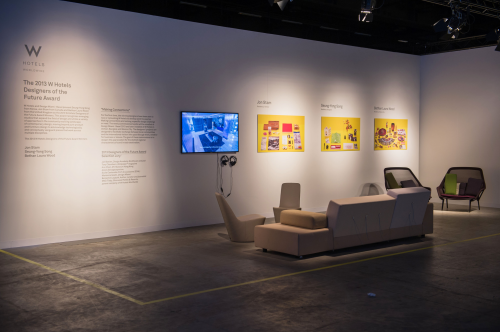
Previous winners of the W Hotels Designer of the Future Award, including Philippe Malouin, Markus Kayser, Tom Foulsham, Asif Khan, Beta Tank, Graham Hudson, Mischer’Traxler, Random International, Studio Juju and Zigelbaum & Coelho, continue to celebrate their successes. W Hotels guides each award winner from the conceptual stage to a level, which ultimately provides a global platform whereby they can expose their work to guests and design enthusiasts alike.
[ w hotels worldwide ]
W Hotels is a contemporary, design-led lifestyle brand and the industry innovator with 44 hotels and retreats, including 16 W-branded residences, in the most vibrant cities and exotic destinations around the world. With more than 14 years of proven success, W Hotels is on track to reach 60 hotels by 2017. [ w hotels residences ] @WHotels #WDOF
[ design Miami/ ]
Design Miami/ is the global forum for design. Each fair brings together the most influential collectors, gallerists, designers, curators and critics from around the world in celebration of design culture and commerce. Occurring alongside the Art Basel fairs in Miami, USA each December and Basel, Switzerland each June, Design Miami/ has become the premier venue for collecting, exhibiting, discussing and creating collectible design. [ design miami blog ] @DesignMiami #DesignMiami
 juvia inside | click > enlarge
juvia inside | click > enlarge
Last December at Design Miami, DesignApplause had the pleasure of interviewing Venezuelan architect Alejandro Barrios-Carrero, along with the good fortune of dining at the inventive restaurant he designed, Juvia. This is a story about an accomplished and talented young architect making the smartest use of today’s tools, materials and a plum venue, the now iconic 1111 Lincoln Road parking facility designed by Herzog & de Meuron.
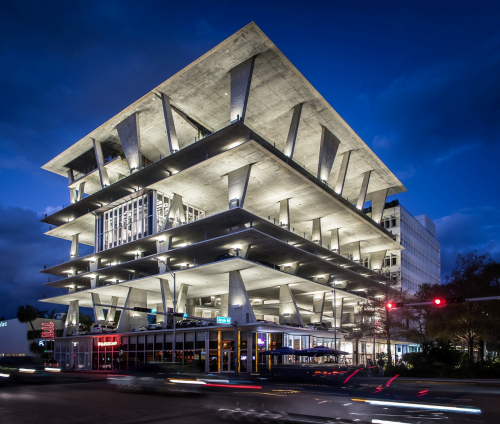 1111 lincoln road
1111 lincoln road
The building itself looks a bit unfinished because it looked too good while under construction to clad.
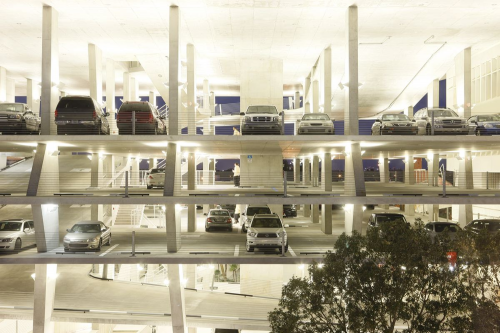
In this setting, rather on top of this setting, Alejandro uses everything in his toolbox to take advantage of his good fortune: Not only the building but he inherits the penthouse and a terrace.

With the penthouse he uses wide mullions to bring the outside to the inside.
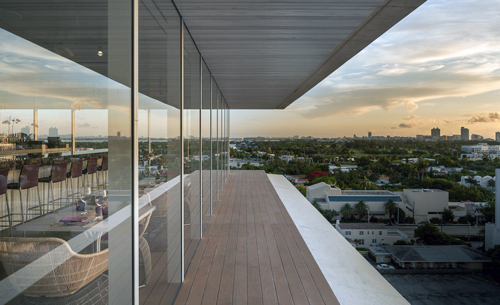
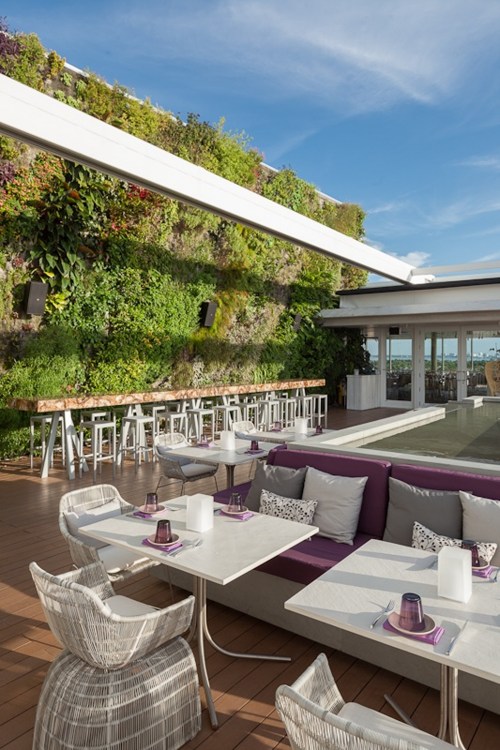
This is South Florida and the architect from Venezuela knows what he needs to do with a soil-less garden wall, a water feature, and a retractable roof.

It comes with little surprise that Alejandro wins a 2013 James Beard Foundation Award For Outstanding Restaurant Design For Juvia (Miami’s penthouse destination for fusion fare takes 76-Seat and over category). Bravo!
[ release ]
The 10,000 square foot indoor/outdoor restaurant, owned by Jonas and Alexandria Millan, and located on the penthouse level of 1111 Lincoln Road features an innovative trackless, retractable roof, a 22-foot high vertical plant wall by acclaimed French botanist Patrick Blanc and furniture and lighting by Patricia Urquiola, Piero Lissoni and Thomas Patterson. The space boasts a panoramic view of downtown Miami, unparalleled by any venue in the city.
“In my opinion, Juvia is what the New Miami should be like,” says designer Alejandro Barrios-Carrero. “It’s much more than art deco for me; I do love it, but I think Miami has much more to offer. The restaurant is part of an equation consisting of architecture, nature, and great food, resulting in a special experience.”
Architecturally inventive, Barrios-Carrero installed a trackless, retractable roof that acts as an umbrella and accommodates terrace dining year-round. A celestial water fountain with wrap-around sofas, situated at the center of the terrace, provides seating and further enhances the atmosphere. The indoor dining room with floor-to-ceiling windows features limestone tabletops and a communal table, made of petrified wood, are accented with organic, hand-woven chairs designed by Patricia Urquiola.
Named after the indigenous Brazilian nut tree, Juvia’s design incorporates elements of nature, creating a magical juxtaposition between the massive concrete structure and a tropical jungle oasis with a subtle integration of organic shapes, colors and materials.
[ james beard foundation awards ]
Covering all aspects of the industry—from chefs and restaurateurs to cookbook authors and food journalists to restaurant designers and architects and more—the James Beard Foundation Awards are the highest honor for food and beverage professionals working in North America. The Awards are presented each spring at Avery Fisher Hall at Lincoln Center. Nominees and winners are fêted at a weekend of events in New York City that has become the social and gastronomic highlight of the year.
[ abc ]
Founded in 2002, Alejandro Barrios-Carrero’s multidisciplinary design studio specializes in hospitality and residential design. Based in Caracas, Venezuela, the firm is internationally known for work that is refined, carefully realized and characteristically modern. The firm’s portfolio includes a wide range of projects, including private homes and commercial establishments in the United States, Venezuela, Panama, and the Dominican Republic.
[ james beard foundation awards ] [ juvia ] [ herzog de meuron ] [ interview ]

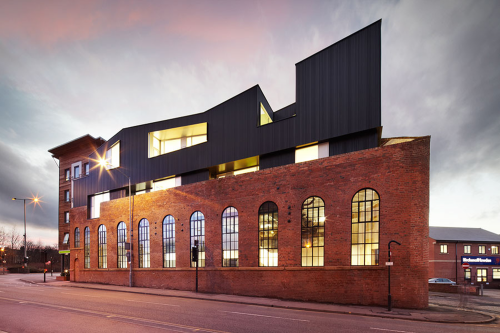 click > enlarge
click > enlarge
a great example of integrating old and new. the original street-level structure is a restaurant.
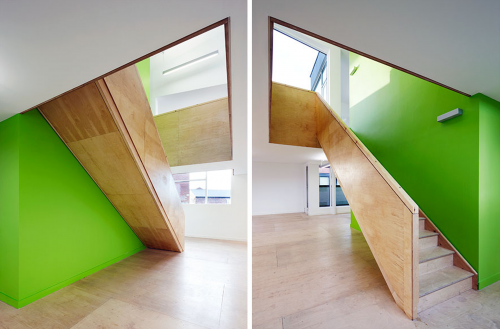
[ project orange ] [ photos jack hobhouse ]
 click> enlarge
click> enlarge
Glass igloos made out of [ heat skin / e-glas ] enabling architects to increase the amount of natural daylight allowed into buildings. A transparent, heat-emitting envelope eliminates the ‘cold wall’ effect and any risk of condensation, as well as delivering the comfort and health benefits of radiant heating. The innovative material is put to good use [ hotel kakslauttanen ]






Pour a boutique hotel lobby into a factory building*. Mix in objects from select naval hardware auctions. The one-of-a-kind Cabos Adujados Lamp made of coiled rope that’s been reclaimed from the La Boca shipyard in Buenos Aires. Creative recipe. (*) Actually, this is just one exhibit of many seen at Casa Foa 2012. Chief cook: Argentinian designer [ Silvina Descole ] [ casa foa 2012 ]

One of many highlights for the Herzog & de Meuron Building* during Design Miami was to visit Juvia, a recently designed pentouse eatery atop the building. Designed by Venezuelan architect and interior designer Alejandro Barrios-Carrero the restaurant straddles the 1111 Lincoln Road office building and a Herzog & de Meuron parking garage. The 10,000 square foot indoor/outdoor restaurant features an innovative trackless, retractable roof, and a 22-foot high vertical plant wall.
[DesignApplause] Alejandro, this project is being billed as Miami’s first restaurant where architecture and design collaborate to play a leading role. What was your vision for the restaurant and how did you achieve it?
[Alejandro Barrios-Carrero] Let me talk about the vision. I think that Juvia is Miami. For me I would describe it that way. Then we can ask, “What is Miami?” For me Miami is much more than its famous Art Deco. For me Miami is about nature, architecture, the sky, the plants.
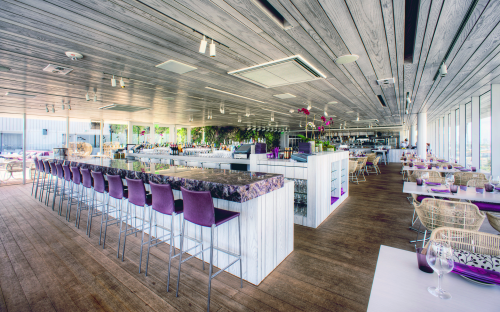
With Juvia we had the opportunity to do many things, from converting an office space into a restaurant, to juxtaposing a high-end restaurant with a parking facility and taking advantage of the penthouse/terrace floorplan.
It was big challenge because usually restaurants are on top of office buildings or tourist attractions. The parking facility is indeed a wonderful architectural statement but it is still a parking garage. The idea and concept is you walk into a private entrance at street level and take a private elevator. The visitor is transported into this oasis that nobody expects and they experience the bringing of the outside inside and the inside outside.
Our philosophy is derived from a good balance of architecture, interior design and landscape. Our office, ABC, put together a good team. For the vertical garden we used acclaimed French botanist Patrick Blanc. The Amazonian-inspired plant wall is a soil-less garden wall, overflowing with greenery native to South Florida. This is his first project in Miami and he’s now doing the Miami Art Museum.
We brought in Thomas Patterson, an Australian designer, for the lighting. There’s a soft orange-amber built-in LED fixture in the ceiling. The kitchen was a collaboration with Russell Stillwell of Next Step Design, from New York.
We used a very limited materials and color palette. We used wood which is very homey and cosy. The wood is on the floor, walls, even the ceiling. The ceiling and some walls are whitewashed white oak. A special detail is in the extended mullions of both floor and ceiling. The illusion created brings the outside inside.

extended mullions of both floor and ceiling bring the outside to the inside
The color palette consists mostly of white with some light grey and purple. We chose purple, a color that shouts with great energy. Purple appears in the amethyst stone topped liquor bar.
For furniture we use a B&B Italia collection by designer Patricia Urquiola. This collection consists of eight elements and all elements are here in the restaurant. The chairs are rope-woven using string for inside and plastic for outside. Inside there are white oak topped dining tables with bases designed by Piero Lissoni. Outside there’s the 8.5 meter communal table with a petrified wood tabletop and a water fountain. On the terrace you have the small tables, also a banquette that surrounds the water feature. The water feature has a visual relationship with the structural columns: The silhouette and texture of the water feature and the structural columns are similar. Tabletops outside are limestone. A nice balance of stone and organics.
Another design element is wanting to have many Juvia’s in one. What does that mean? We created a restaurant where you can come to the same place four times and you can feel very different experiences. It’s very different experience to dine on the outside terrace versus eating inside.
Inside you have the experience of dining at the liquor bar. Another venue is a banquette table, another the central tables, and yet another tables next to the windows. Each location offers a very different experience. Also, there’s not one chair that doesn’t have a beautiful view.
Juvia is sexy, understated luxury, it’s relaxed, it’s what Miami exudes. Juvia brings identity to the city, personality, and much more the Art Deco heritage I love and respect. We bring something to the city that it didn’t have before.
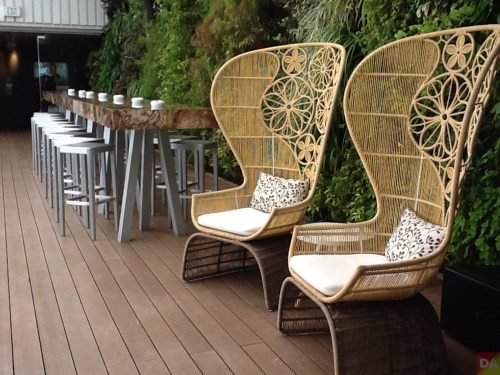
[DA] You inherited a great space, a great vision, a great structure, and you’ve melded your vision together with the structure and enhanced this space. Totally seamless.
[ABC] Thank you. Exactly, the seamless connection with the old building and the new restaurant. I think it’s about understanding this space, the overriding energy we have talked about. It’s about our vision respecting the existing structure, the magnificent parking facility, the understanding of the architecture here as this is a very architonic restaurant. Now you can have a dialog about what is interior design, what is architecture.
[DA] When you came in, did you need to talk to Herzog?
[ABC] No. They sent us the drawings, they recommended Patrick Blanc. Patrick was very excited because it was his first time that he does a restaurant where he’s called in at the beginning of the project rather than at the end. We collaborated with the plant selection: There are over 200 varieties in this space. Juvia by the way is named after the indigenous Brazilian nut tree.
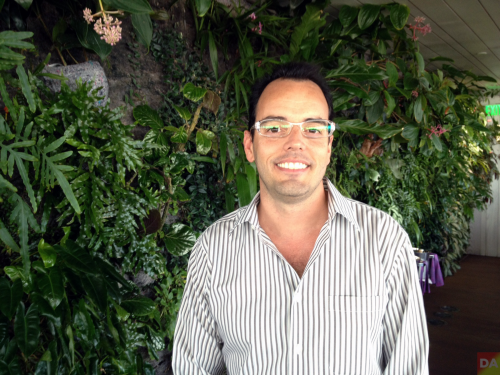
alejandro barrios-carrera
[DA] Not part of dialog but a comment: One of the things that’s so special about this project is Alejandro understands where it is. He understands that it’s part of Miami and it’s part of the Herzog de Meuron parking garage. And he takes as some of his inspiration some of Herzog’s lines. You can see it in the fountain, the angles and the silhouette of the structure, the concrete to engage in a relationship with the Herzog building.
There’s also a relationship with the 1970s building. For example the wood planks in the ceiling are similar to the concrete planks in the older building. You can notice that the planks widths are different and that’s similar to the detail landscape architect Raymond Jungles installs at street level in front of 1111. Alejandro cleverly and subtly captures the essence of the creation.
(*) formerly the SunTrust Bank building, purchased by developer Robert Wennett in 2005 who hired the Swiss firm, and effectively shored up the west end of Lincoln Road at Alton Road. [ juvia ] [ herzog &de meuron ]

photos courtesy of patrick norguet
Design Democracy – From Cappellini to McDonalds – Patrick Norguet doesn’t discriminate. McDonalds hires one of Frances top creatives, Patrick Norguet to design an outdoor collection. In collaboration with the producer Alias and the fast-food giant McDonald’s, designer Patrick Norguet has designed a line of outdoor furniture as part of McDonald’s “Come” project. The furniture collection will equip terraces and outdoor spaces McDonald’s worldwide. [ patrick norguet ] [ alias ]

The design solution responds to the ‘COME’ objectives – to design, engineer, develop and install a specific turnkey modular furniture system. The collection consists of 28 pieces made of steel, hand-sanded concrete and Corian tables, chairs, benches, lamps, planters, litter bins and screen. The introduction of the collection will be in Bordeaux and northern France.

Patrick Norguet says:
“I’m lovin it.”“For this project, like each of my projects, I wanted to give great attention to the final use. Draw a quality space that fits into the time that meets the demands and requirements specific to McDonald’s. Not all completely outside or completely inside the terrace is experienced as an extension of the restaurant, a separate space for a different experience. It is also a major project for me because we were able to connect two worlds around the project, and thus develop products of high quality. The association with Alias, I was able to reach the level of demand that I wanted for this set consists of 28 objects. A family of tables, chairs, low chairs, lamps, planters, benches, litter bins and screen.”





Paris council has unveiled plans for a 50-story glass pyramid after voting to drop a ban on high-rise buildings.
Proposals for the Project Triangle, designed by Swiss architecture practice Herzog & de Meuron who designed the Olympic stadium in Beijing. The tower will have offices, a conference center, 400-bedroom hotel and restaurants and cafes. It will be surrounded by parks, gardens and shops. The building is planned to be around 590 feet high which will make the third highest building in Paris. The tower will run on solar and wind power and is set for completion in 2012.
All content ©2007 > 2024 DesignApplause
Notifications